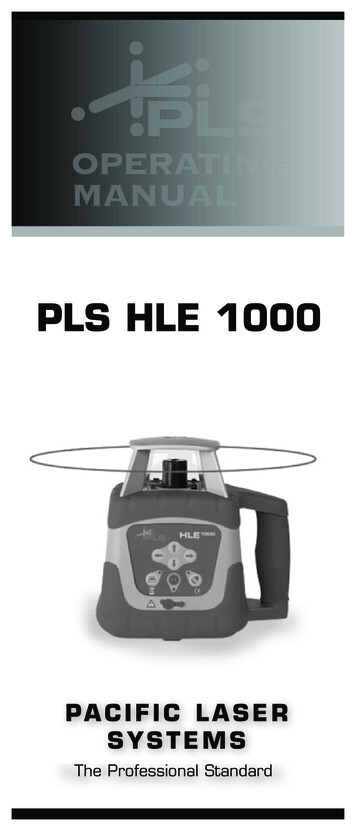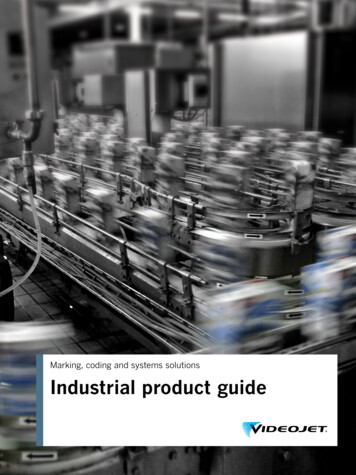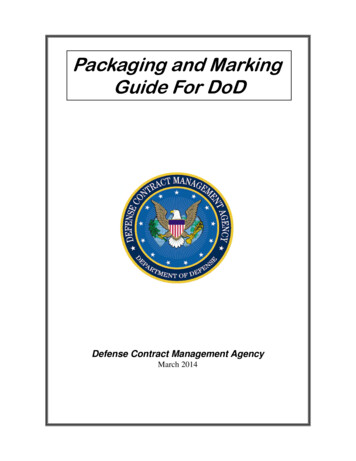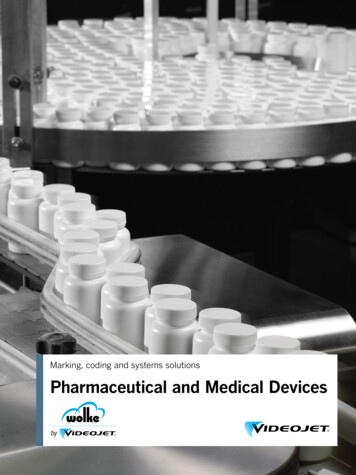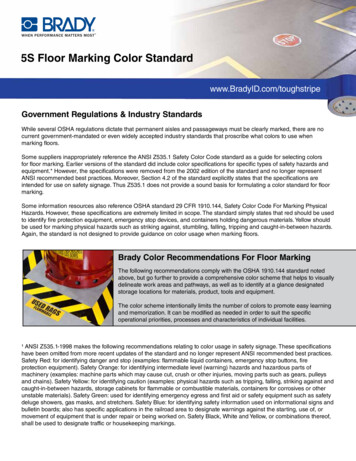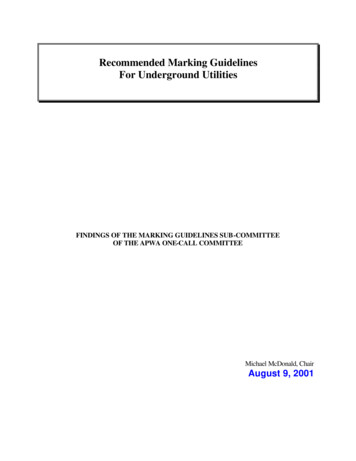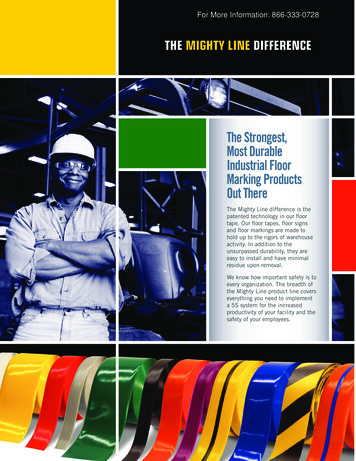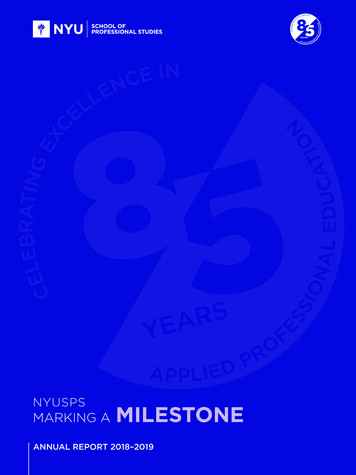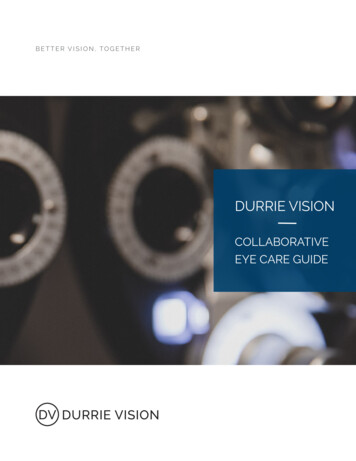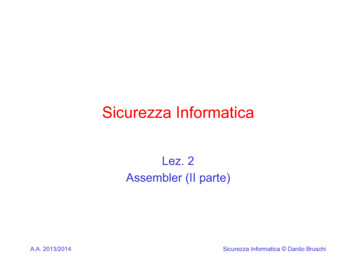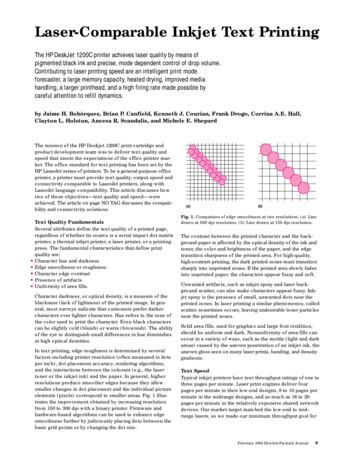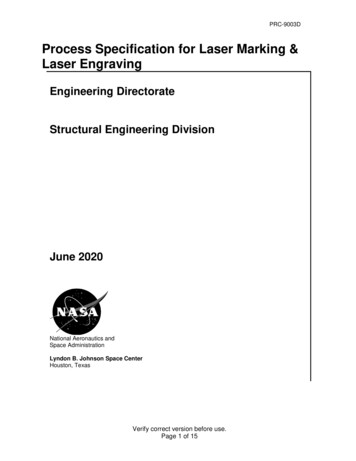
Transcription
PRC-9003DProcess Specification for Laser Marking &Laser EngravingEngineering DirectorateStructural Engineering DivisionJune 2020National Aeronautics andSpace AdministrationLyndon B. Johnson Space CenterHouston, TexasVerify correct version before use.Page 1 of 15
PRC-9003DProcess Specification for Laser Marking &Laser EngravingPrepared by:Signature on FileDaila GonzalesMaterials and Processes Branch/ES406/11/2020DateReviewed by:Signature on FileJohn FigertMaterials and Processes Branch/ES406/11/2020DateApproved by:Signature on FileBrian MayeauxMaterials and Processes Branch/ES406/11/2020DateVerify correct version before use.Page 2 of 15
PRC-9003DREVISIONSCHANGESVERSIONDATE--Original versionMarch 3, 1996AReformatted to new PRC format, updated paragraph.2.0July 27, 1999BUpdated list of materials that can be laser engraved undersection 2.0; added paragraph to section 2.0 specifying thatlaser engraving of titanium alloys in air is notrecommended; deleted all references to Universal LaserSystems Inc. Model ULS-25 engraving system; replacedEM-007.1 with SOP-007.1, added paragraph to section 8.0dspecifying to perform a metallurgical inspection/evaluationof laser engraved coupon to confirm established systemparameters are acceptable for a given part; replaced EM2with ES4 where applicable.03/09/2012CUpdated sample process notes to call out lasermarking/laser engraving under section 3.0 USAGE;modified subsections under 3.0 USAGE; added AMS- H6875 and JSCM 5312 to section 4.0 REFERENCES; addedTable 1, Approved Materials for Filled Impressions tosection 5.0 TOOLS, EQUIPMENT, and MATERIALSREQUIREMENTS; modified section 6.0 PROCESSREQUIREMENTS; modified section 7.0 PROCESSQUALIFICATION, modified subsection 7.1 PROCESSQUALIFICATION DOCUMENTATION; modifiedsection 8.0 PROCESS VERIFICATION10/26/2012DUpdated revision, date, and Approved by signature; addedreviewed by signature; updated Section 2.0APPLICABILITY; noted chemical conversion coating shallnot be used as corrosion protection on filled engravedimpressions in Section 2.0; added statements to Section 3.0USAGE stating when to laser mark and when to laserengrave and referenced Section 10.0 on processdistinctions; deleted additional marking requirements forSpace Station Payloads per SSP 57000, Appendix C underSection 3.0; added statements to Section 3.0recommending to laser engrave/mark in low stress locationsso as to prevent cracking and fatigue; moved steelrestrictions to Section 3.2 RESTRICTIONS; reworded factorsto consider when selecting laser marking/engraving locationin Section 3.4 CHARACTER LOCATION AND LIGIBILITY;updated Section 10.0 Definitions; minor grammaticalcorrections.06/2020Verify correct version before use.Page 3 of 15
PRC-9003D1.0SCOPEThis process specification establishes the requirements for laser marking and laserengraving of flight and non-flight hardware manufactured by JSC or outside vendors.2.0APPLICABILITYThis process specification applies to laser marking and laser engraving on the surface ofmaterials such as wood, acrylic, engraver’s plastic, glass, leather, stone, rubber, somesteels, cobalt-based alloys, aluminum, titanium, and copper-based alloys (except C17200).Coated metals may be laser marked/engraved using this procedure. The process cancompletely remove the coating, but it shall not significantly compromise the base material.Before using this process, it shall be verified with NASA-JSC/M&P that complete removal ofthe coating will not adversely affect the performance of the base material. Chemicalconversion coatings shall not be used for corrosion protection on laser engraved aluminumalloys as when for instance laser engraving penetrates past the anodic coating. Engravedimpression shall be filled with primer instead, and color paint if desired.3.0USAGEThis section gives the requirements for the proper design usage of this processspecification.Laser marking is generally used for identification purposes, when assigning a part number(P/N) and/or serial number (S/N) to component parts. Laser engraving is generally used forindication purposes on tools, when filling engraved impression with color paint for example.Section 10.0 provides a distinction between laser marking and laser engraving.Laser marking and/or laser engraving shall be invoked by a process note on the engineeringdrawing. The process note shall reference this PRC. Character height and depth (whenapplicable) shall follow, along with any additional requirements. In addition, the processnote shall specify the location of the characters. The following are example process notes:LASER ENGRAVE PART with {words, numbers, arrows, alignmentmarks, etc.} PER NASA/JSC PRC-9003. CHARACTER HEIGHT SHALL BE3/16 INCH. CHARACTER DEPTH SHALL BE 0.003 INCH. LOCATEAPPROXIMATELY AS SHOWN.LASER MARK PART with {words, numbers, arrows, alignment marks,etc.} PER NASA/JSC PRC-9003. CHARACTER HEIGHT SHALL BE 3/16INCH. LOCATE APPROXIMATELY AS SHOWN.Verify correct version before use.Page 4 of 15
PRC-9003DLaser marking/engraving shall be performed on low stress locations within a part, wherefatigue propagation is not expected to occur.Work-hardened alloys can be adversely effected by laser marking/engraving. Changes in theresidual stress at the surface after laser processing can make the surface more prone tofatigue or stress corrosion cracking.Gears should be marked in low-stress locations away from carburized regions. Lasers notonly produce cracks in carburized (and nitrided) surfaces from untempered martensite, butalso create burn (decarburization).Laser mark/engrave away from high stress locations like fillets, part edges and bolt holes.3.1BASE MATERIALSThe minimum base material thickness for all metallic, molded, or sheet plastic materials tobe laser marked/laser engraved shall be 0.030 inch. The minimum base material thicknessfor multi-layer or reinforced laminates shall be 0.060 inch.3.2RESTRICTIONSLaser marking/engraving of parts shall not be performed on the following items withoutprior NASA-JSC/M&P approval:a.Ferrous parts heat-treated above 160 ksi ultimate tensile strength (UTS) and metallicparts work-hardened above one-fourth harder than the normal annealed condition.b.Surfaces contoured to a dimensionc.Areas where subsequent metal removal will obliterate themarking/engravingd.Less than 1/4 inch from weld beadse.Metal tank skinsf.Pressure tubing and push-pull control tubingg.Pressure vesselsThere are specific restrictions on the classes of steels that can be laser marked/engraved.AMS-H-6875 classifies steels into four classes: Class A (carbon and low alloy steels) – i.e.: 4140, 4340, 52100, carburized 9310 Class B (martensitic corrosion-resistant) – i.e.: 410, 416, 420, 440C Class C (austenitic corrosion-resistant) – i.e.: 302, 304, 304L, 316, 316L Class D (precipitation hardening) – i.e.: 15-5PH, 17-4PH, Custom 455, Custom 465Verify correct version before use.Page 5 of 15
PRC-9003DClass A, Class B, and some Class D steels shall not be laser marked/engraved. High levels of untempered martensite may form after laser marking/engraving onClass A and B steels. Cracks and brittle, untempered martensite are produced on Class D steels such asCustom 455 and Custom 465 as a result of the laser marking/engraving process.Laser marking/laser engraving may be performed on Class C (i.e.: 302, 304, 304L, 316,316L) steels. Prior M&P approval is required to laser mark/engrave Class C steels workhardened above one-quarter hard as noted in section 3.2a.Some class D (i.e.: 15-5PH and 17-4PH) steels may be laser marked/engraved. Prior M&Papproval is required to laser mark/engrave Class D steels.3.3CHARACTER SIZECharacter size shall be specified on the engineering drawing. The choice of character heightshall be in increments of 1/32 inch, from 1/16 to 1/2 inch inclusive. Character size inaccordance with the point value system is acceptable, with 12-point being preferred. Thesize of characters shall be proportioned to the area available for laser marking/laserengraving. The size of characters shall be uniform from part to part within the practical limitsof readability. An example of the character size callout is as follows:CHARACTER HEIGHT SHALL BE 3/16 INCH.Characters shall be marked/engraved to a depth necessary to obtain the required width forlegibility. The depth of the character shall be 0.003 minimum, and shall not exceed 50percent of the base material thickness.CHARACTER DEPTH SHALL BE 0.003 INCH.3.4CHARACTER LOCATION AND LEGIBILITYThe location of the characters shall be specified on the engineering drawing. The characterlocation shall be indicated on the drawing with a flagged box. The general configuration fora flag note to specify the character location is shown in Figure 1:Figure 1: Flag note configuration sketch designating character location.Specific information on the laser marking/laser engraving format for part and serialnumbers, and how to write the flag note to indicate laser marking/laser engravingVerify correct version before use.Page 6 of 15
PRC-9003Dplacement may be found in Section 3.5. Factors that shall be considered when specifying amarking/engraving location include: damage to a critical surface due to laser marking/engraving. part number visibility at next assembly, top assembly, or installation level. obliteration of laser marking/engraving during assembly process legibility of component part numbers during verification process.Assembly laser markings or laser engravings shall be legible under conditions of normalvision in daylight, or in equivalent illumination.3.5FORMAT FOR PART AND SERIAL NUMBERSEach part or assembly shall be identified, except those parts which are permanentlyattached to other parts or assemblies (i.e. welding, brazing, or soldering). Parts which donot require identification may be marked/engraved for production convenience, providedthe marking/engraving conform to the requirements of this specification. Any itemmarked/engraved per this specification shall include, as a minimum, the complete partnumber as shown in Figure 2.Figure 2: Example of identification marking/engraving consisting of a complete part number.Additional information to be included in the marking/engraving, such as the serial number,may be indicated on the engineering drawing in the drawing flag note. The information maybe located below the part number or adjacent to it. Figure 3 shows an example of how tospecifically indicate that the information shall be placed adjacent to the part number.Figure 3: Example of symbol to be used if information is to be located adjacent to the part number.Figure 4 shows an example of how to mark/engrave the additional information below thepart number.Verify correct version before use.Page 7 of 15
PRC-9003DFigure 4: Example of symbol to be used if information is to be located beneath the part number.3.5.1Serial NumbersBatch or lot controlled parts do not require serial numbers if a mandatory traceable batch lotsystem is used. All other parts or assemblies shall have serial numbers as specified in JPR8500.4. A general example of the marking format for part and serial numbers is indicated inFigures 3 and 4.3.5.2AssembliesAssemblies not identified with a nameplate that includes nomenclature of the part shall havethe word “assembly” or “assy” placed immediately below the part number and serial number,as shown in Figure 5.Figure 5: Example of identification markings/engravings on hardware that is part of an assembly.3.5.3EquipmentEquipment (i.e., valves, pumps, etc.) shall be marked/engraved with the following minimuminformation, in the order noted: Nomenclature, Part Number, Serial Number, ContractNumber, Manufacturer, NASA-JSC.3.5.4Explosive DevicesExplosive devices shall be marked/engraved with the following minimum information:Nomenclature, Contractor, Manufacturer, Part Number, Lot Number, Serial Number, Date ofManufacture, ICC Classification.3.5.5Non-Flight HardwareHardware or equipment which is not suitable for use in flight and which could be accidentallysubstituted for flight articles shall be marked/engraved as either “Class III Not For Flight” or“Class II Controlled Equipment,” as shown in Figure 6.Verify correct version before use.Page 8 of 15
PRC-9003DFigure 6: .Examples of the two options for laser marking/engraving non-flight hardware described inSection 3.5.5.3.5.6Rejected Flight HardwareHardware or equipment too small to be so marked/engraved shall be tagged with anappropriate red tag which is conspicuously identified: “Class II Controlled Equipment” or“Class III Not For Flight” per JSCM 5312 as shown in Figure 6.3.6FILLED IMPRESSIONSIf desired, marking/engraving impressions can be filled with a permanent coating in acontrasting color. The preferred color for filled impressions shall be black or white formaximum contrast. Filled impressions of other colors having contrast to the part are alsoacceptable. The product name and color of the coating used to fill impressions shall bespecified on the engineering drawing in the parts list. Table 1 lists acceptable primer andcoating products.Filled impressions are specified by addition of one of the following process notes, dependingon whether or not primer is required:IMPRESSIONS SHALL BE FILLED WITH {material}orPRIME WITH {primer} AND FILL IMPRESSIONS WITH {material}Primer must be used for filled flight hardware engravings, but is not necessary for groundsupport hardware. Both the primer and the filling material shall be added to the drawingparts list. Additional details regarding materials requirements for filled engravings aregiven in Section 6.4.1.4.0REFERENCESThe following references were used to develop this process specification:SOP-007.1Preparation and Revision of Process SpecificationsJPR 8500.4Engineering Drawing System ManualAMS-H-6875Heat Treatment of Steel Raw MaterialsVerify correct version before use.Page 9 of 15
PRC-9003DJSCM 53125.0Safety, Reliability, and Quality Assuran
AMS-H-6875 classifies steels into four classes: Class A (carbon and low alloy steels) – i.e.: 4140, 4340, 52100, carburized 9310 Class B (martensitic corrosion-resistant) – i.e.: 410, 416, 420, 440C Class C (austenitic corrosion-resistant) – i.e.: 302, 304, 304L, 316, 316L Class D (precipitation hardening) – i.e.: 15-5PH, 17-4PH, Custom 455, Custom 465 . PRC-9003D Verify correct .
